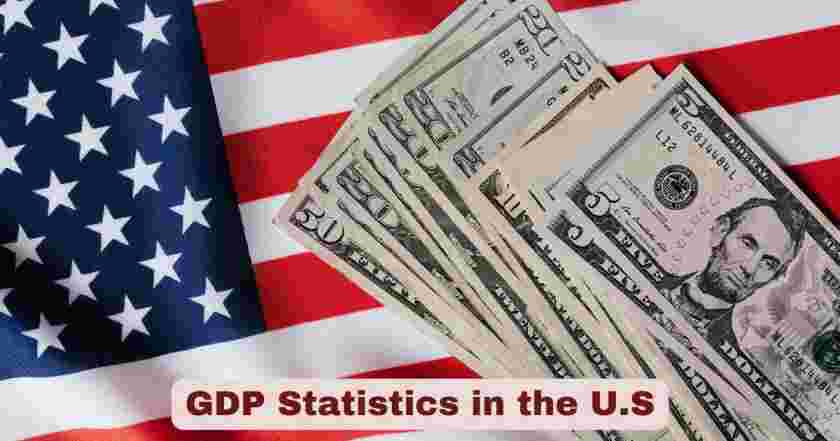Gross Domestic Product (GDP) in the US 2025
The Gross Domestic Product (GDP) of the United States in 2025 reflects a complex blend of resilience, cyclical adjustment, and evolving global economic interdependencies. As the world’s largest economy, the US GDP not only serves as a critical benchmark for domestic prosperity but also as a bellwether for global financial stability. In the first quarter of 2025, the economy posted a 0.5% contraction at an annualized rate, marking a notable reversal from the 2.4% growth recorded in the fourth quarter of 2024. This decline underscores the natural ebb and flow of economic cycles and the responsiveness of GDP to trade dynamics, sector-specific performance, and fiscal developments. Importantly, this contraction was not driven by weakened demand but rather by a surge in import activity, which subtracts from GDP in the national accounts framework. In effect, this signals strong domestic demand and consumer purchasing power, despite the technical decrease in output.
Looking deeper into the numbers, the US economy in 2025 displays sectoral divergence that reveals its adaptive strength. While private goods-producing industries shrank by 2.8%, weighed down by supply chain realignments and manufacturing slowdowns, private services-producing sectors experienced only a slight 0.3% decline, showcasing their comparative stability. In contrast, the government sector grew by 2.0%, acting as a fiscal cushion and reinforcing the role of public investment during periods of private sector softness. At the same time, the current account deficit widened significantly to $450.2 billion, now equaling 6.0% of GDP, as consumer and business import activity accelerated. While this trade imbalance negatively affected GDP figures, it also illustrates the economic strength underpinning US consumption trends. Together, these patterns emphasize the multifaceted nature of economic performance in 2025, where headline GDP figures tell only part of a broader story about underlying demand, sectoral resilience, and international trade flows.
GDP Stats & Facts in the US 2025
| Economic Indicator | Value/Percentage | Time Period | Source |
|---|---|---|---|
| Real GDP Growth Rate | -0.5% (annual rate) | Q1 2025 | US Bureau of Economic Analysis |
| Previous Quarter Growth | +2.4% (annual rate) | Q4 2024 | US Bureau of Economic Analysis |
| Primary GDP Decline Factor | Increased Imports | Q1 2025 | US Bureau of Economic Analysis |
| Private Goods-Producing Industries | -2.8% decline | Q1 2025 | US Bureau of Economic Analysis |
| Private Services-Producing Industries | -0.3% decline | Q1 2025 | US Bureau of Economic Analysis |
| Government Sector Growth | +2.0% increase | Q1 2025 | US Bureau of Economic Analysis |
| Current Account Deficit | $450.2 billion | Q1 2025 | US Bureau of Economic Analysis |
| Deficit as % of GDP | 6.0% | Q1 2025 | US Bureau of Economic Analysis |
The first quarter of 2025 highlights a pivotal moment in the trajectory of the U.S. economy, as real GDP contracted by 0.5% at an annual rate, according to the Bureau of Economic Analysis (BEA). This decline marks a significant shift from the 2.4% growth recorded in the fourth quarter of 2024 and is primarily attributed to a surge in imports, which exerted a negative mathematical effect on GDP figures. Under the national accounting framework, imports are subtracted from gross output because they represent spending on goods and services not produced domestically. The sharp rise in imports reflects strong consumer demand and investment appetite, indicating underlying economic strength. However, this technical impact on GDP creates the appearance of a contraction, even though domestic economic activity in sectors like retail, construction inputs, and consumer technology remains relatively robust.
At a sectoral level, the data tells a more nuanced story of mixed performance and resilience. Private goods-producing industries—which include manufacturing, mining, and construction—suffered a 2.8% decline, driven by lingering supply chain bottlenecks, slower factory orders, and input cost volatility. Meanwhile, the private services-producing industries, which dominate the U.S. economy, experienced only a 0.3% decline, demonstrating more stability in consumer-facing sectors such as finance, education, and healthcare. The government sector posted a 2.0% increase, reflecting active fiscal spending and infrastructure investments that helped cushion the downturn. Additionally, the current account deficit widened sharply to $450.2 billion, representing 6.0% of GDP, as foreign imports continued to outpace exports. While this growing trade gap weighed heavily on headline GDP, it simultaneously underscores America’s role as a global consumption powerhouse, where strong domestic demand drives both opportunity and economic imbalance.
GDP Growth in the US 2025
| Sector | Performance (Q1 2025) | Key Insight |
|---|---|---|
| Real GDP (Overall) | -0.5% | Moderate contraction due to import surge |
| Private Goods-Producing Industries | -2.8% | Manufacturing and construction slowdown |
| Private Services-Producing | -0.3% | Resilient consumer-facing sectors |
| Government Sector | +2.0% | Public spending supports GDP |
| Primary Drag on GDP | Imports Increased | Subtracted from GDP measurement |
The GDP performance in the first quarter of 2025 offers a nuanced picture of the US economy, marked by a 0.5% contraction in real GDP at an annualized rate. This slowdown is largely attributed to a substantial increase in imports, which by national accounting standards are subtracted from GDP, thus exerting downward pressure on the overall growth figure. While this decline may appear concerning on the surface, it reflects strong domestic demand and consumer activity, signaling economic vitality rather than weakness. The trade balance effect underscores the close link between global trade dynamics and national output measurement, particularly in a highly import-reliant economy like the United States.
Sector-wise, the economy displayed varying levels of performance. Private goods-producing industries, which include sectors such as manufacturing, mining, and construction, saw a 2.8% decline, impacted by supply chain adjustments and cost pressures. Private services-producing industries showed more resilience, posting only a 0.3% decrease, supported by steady consumer spending in sectors like finance, education, and healthcare. Notably, the government sector grew by 2.0%, acting as a stabilizing force through increased public investments and spending. This distribution highlights how government intervention and the diversified structure of the US economy can cushion against sector-specific contractions and global trade volatility.
Historical GDP Growth in the US 2015-2024
| Year | Annual GDP Growth Rate | Key Economic Events | GDP Characteristics |
|---|---|---|---|
| 2015 | 2.9% | Federal Reserve Policy Normalization | Steady Recovery Growth |
| 2016 | 1.7% | Presidential Election Year | Moderate Expansion |
| 2017 | 2.4% | Tax Reform Legislation | Business Investment Surge |
| 2018 | 2.9% | Trade Policy Changes | Strong Corporate Performance |
| 2019 | 2.2% | Global Trade Tensions | Resilient Consumer Spending |
| 2020 | -2.2% | COVID-19 Pandemic Impact | Economic Contraction |
| 2021 | 5.8% | Recovery and Stimulus | Rapid Economic Rebound |
| 2022 | 2.1% | Inflation Concerns | Post-Pandemic Normalization |
| 2023 | 2.5% | Monetary Policy Tightening | Stable Growth Pattern |
| 2024 | 2.4% | Election Year Dynamics | Continued Expansion |
The decade from 2015 to 2024 showcases the remarkable adaptability and resilience of the American economy through various economic cycles and unprecedented challenges. The period began with steady recovery growth following the 2008 financial crisis, with 2015 recording a solid 2.9% GDP growth rate. The subsequent years demonstrated typical economic fluctuations, with 2016 showing a more moderate 1.7% growth during the presidential election year, followed by 2017’s improved 2.4% performance that coincided with significant tax reform legislation.
The most dramatic economic event of this period occurred in 2020 when the COVID-19 pandemic caused the first negative GDP growth since the 2008 recession, with the economy contracting by 2.2%. However, the American economy demonstrated exceptional recovery capabilities, achieving a remarkable 5.8% growth rate in 2021 – the highest in the analyzed period. This recovery was supported by massive fiscal stimulus measures, accommodative monetary policy, and the economy’s inherent structural strengths. The subsequent years showed a return to more normalized growth patterns, with 2022, 2023, and 2024 recording 2.1%, 2.5%, and 2.4% respectively, indicating sustained economic expansion despite various global challenges.
Sectoral GDP Distribution in the US 2025
| Economic Sector | Performance Rate | Contribution Level | Growth Factors |
|---|---|---|---|
| Private Goods-Producing | -2.8% | Significant Decline | Supply Chain Disruptions |
| Private Services-Producing | -0.3% | Mild Contraction | Consumer Spending Patterns |
| Government Operations | +2.0% | Positive Growth | Public Sector Investment |
| Investment Activities | Positive Growth | Offsetting Factor | Business Confidence |
| Consumer Spending | Positive Growth | Supporting Element | Household Resilience |
| Export Activities | Positive Growth | Trade Contribution | Global Demand |
| Import Activities | Increased Levels | GDP Reduction Factor | Strong Domestic Demand |
The sectoral distribution of GDP performance in the first quarter of 2025 reveals important insights about the structural dynamics of the American economy. The private goods-producing industries experienced the most significant impact with a 2.8% decline, reflecting challenges in manufacturing, construction, and other tangible goods sectors. This contraction likely stems from various factors including supply chain disruptions, changing consumer preferences, and global trade dynamics that have affected production capabilities and demand patterns.
The private services-producing industries demonstrated greater resilience with only a 0.3% decline, showcasing the stability of America’s service-oriented economy. This sector includes finance, healthcare, education, professional services, and technology – areas that have proven more adaptable to changing economic conditions. Meanwhile, the government sector’s 2.0% growth indicates that public sector spending and investment continued to support economic activity during the quarter. The positive performance in investment activities, consumer spending, and export activities demonstrates that despite the overall GDP decline, several fundamental economic drivers remained strong, suggesting that the first quarter contraction may represent a temporary adjustment rather than a sustained economic downturn.
Trade Balance Impact on GDP in the US 2025
| Trade Component | Value (Billions) | Impact on GDP | Economic Significance |
|---|---|---|---|
| Current Account Deficit | $450.2 billion | Negative Contribution | Trade Imbalance Indicator |
| Previous Quarter Deficit | $312.0 billion | Comparative Baseline | Quarterly Change Reference |
| Deficit Increase | $138.2 billion | GDP Reduction Factor | Import Surge Impact |
| Deficit Growth Rate | 44.3% | Significant Expansion | Trade Policy Implications |
| Deficit as GDP Percentage | 6.0% | Economic Proportion | Fiscal Health Indicator |
| Import Activity | Increased Substantially | Primary GDP Detractor | Consumer Demand Strength |
The trade balance dynamics in the first quarter of 2025 played a crucial role in shaping overall GDP performance, with the current account deficit expanding dramatically to $450.2 billion from the previous quarter’s $312.0 billion. This $138.2 billion increase represents a 44.3% expansion in the trade deficit, which directly contributed to the GDP contraction since imports are subtracted from GDP calculations. The deficit now represents 6.0% of current-dollar GDP, indicating a significant portion of domestic economic activity is supported by foreign-produced goods and services.
The substantial increase in import activity reflects several important economic dynamics within the American economy. Strong domestic demand, robust consumer spending power, and business investment needs drove increased purchases of foreign goods and services. While this import surge technically reduced GDP calculations, it simultaneously demonstrates the underlying strength of domestic economic demand and consumer confidence. The trade deficit expansion also reflects the interconnected nature of the global economy and America’s role as a major consumer market, where domestic prosperity enables increased international trade activity that supports global economic growth while temporarily impacting domestic GDP measurements.
Disclaimer: The data research report we present here is based on information found from various sources. We are not liable for any financial loss, errors, or damages of any kind that may result from the use of the information herein. We acknowledge that though we try to report accurately, we cannot verify the absolute facts of everything that has been represented.







